Key takeaways:
- Regular audits and team collaboration are vital for identifying data quality issues and fostering a culture of accountability.
- Establishing clear data standards and consistent training enhances data accuracy and builds confidence among team members.
- Leveraging technology, such as automated tools and feedback systems, significantly improves data monitoring and overall management efficiency.
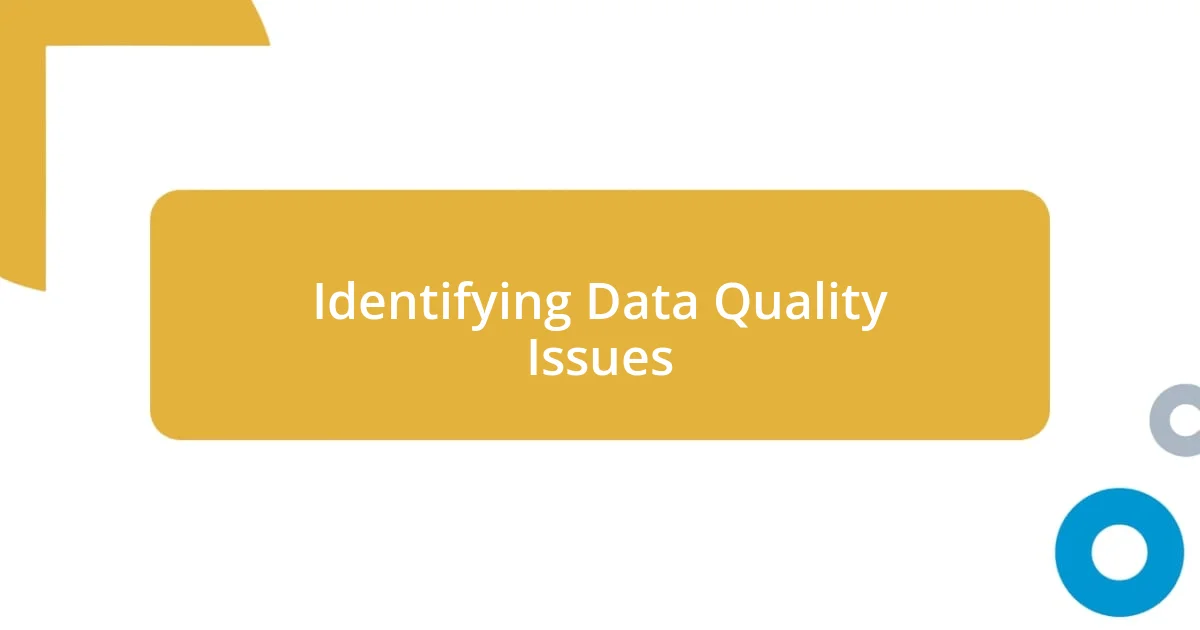
Identifying Data Quality Issues
Identifying data quality issues can sometimes feel like searching for a needle in a haystack. I remember sifting through spreadsheets filled with customer information and noticing unexpected gaps and duplicates. Have you ever felt that sinking feeling when your data just doesn’t add up? It’s incredibly frustrating and can lead to serious consequences.
One of the most effective ways I found to spot these issues was by setting up regular audits. As I meticulously checked data sets, I often stumbled upon inconsistencies that I initially overlooked. This process was a blend of detective work and alarm bells ringing in my head—each anomaly prompting me to ask, “What else am I missing?”
Additionally, involving my team in discussions about data accuracy unveiled perspectives I hadn’t considered. When we shared insights, I realized that everyone had their unique experiences with data mishaps. It really struck me how collective scrutiny could uncover issues that might have remained hidden if I worked alone. Doesn’t it make you think about the power of collaboration when it comes to maintaining data integrity?
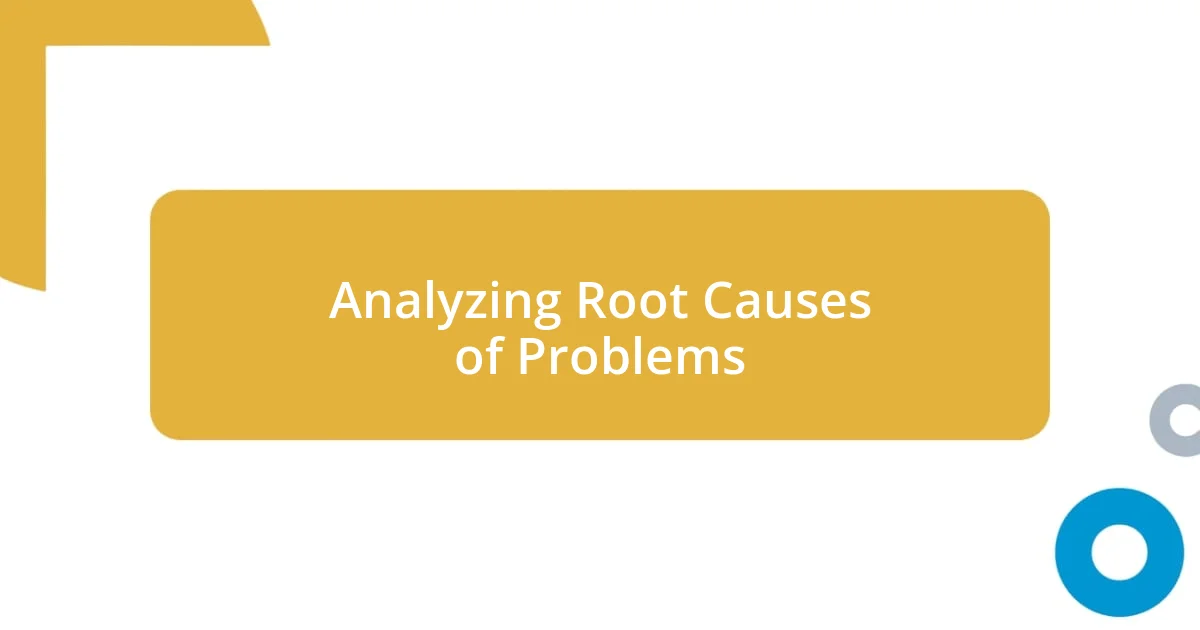
Analyzing Root Causes of Problems
When tackling data quality issues, analyzing root causes is essential. I recall a specific incident where our customer relationship management (CRM) system showed inconsistent sales data. One day, I dove deep into these discrepancies, armed with nothing but determination and a few cups of coffee. Through this investigation, I discovered that different teams used varied definitions of a “sale,” leading to conflicting reports. It’s moments like these that remind me: understanding the why behind the problems is just as crucial as identifying the problems themselves.
To effectively analyze root causes, consider these steps:
- Conduct Thorough Interviews: Engage with stakeholders to gain insights into their processes and data usage. I’ve found that people often have valuable experiences that reveal underlying issues.
- Trace Data Flow: Map out how data is collected, processed, and utilized. This visual can highlight where inconsistencies arise.
- Review Documentation: Look at existing data entry guidelines and processes. One time, I uncovered that outdated procedures were still being followed, causing confusion.
- Analyze Patterns: Use statistical tools to find trends or anomalies in the data. I once spotted a pattern that pointed to a systemic error stemming from a software update.
- Test Hypotheses: Formulate potential explanations and test them. This iterative approach can lead to deeper insights and ultimately resolve the root issue.
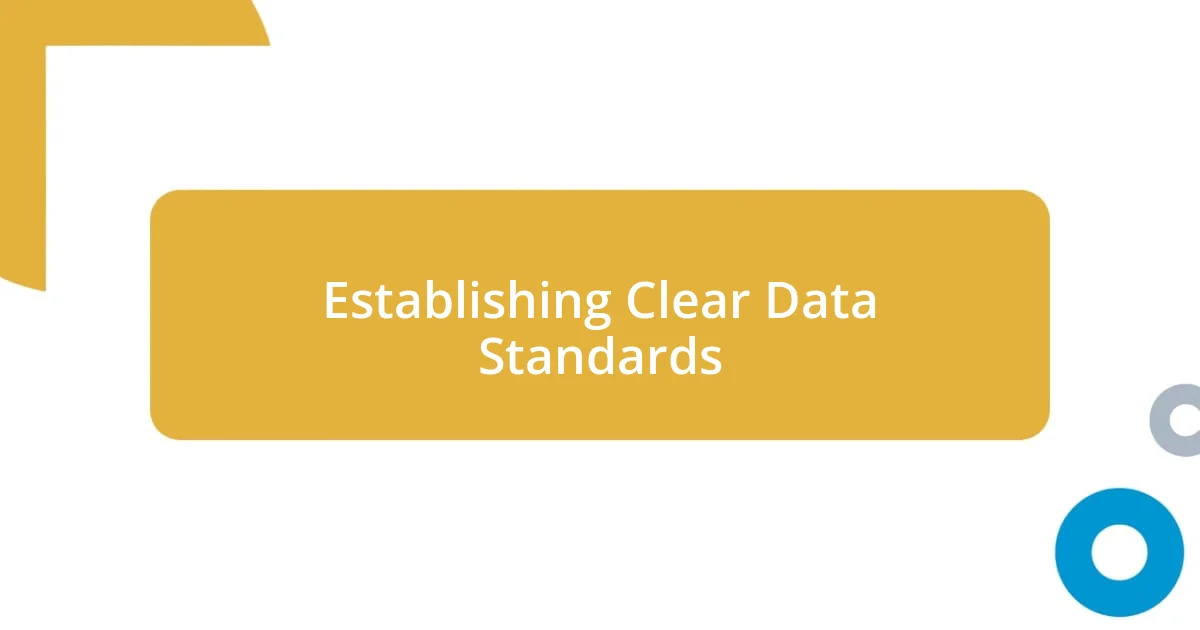
Establishing Clear Data Standards
When establishing clear data standards, clarity is your best friend. I vividly remember a project where my team faced chaotic data entries. One afternoon, we gathered around the conference table, coffee in hand, and decided on a comprehensive data dictionary. This living document laid out our definitions for fields like “customer” and “transaction,” eliminating ambiguity. I can’t stress enough how that moment transformed our approach; everyone was suddenly on the same page, and accountability soared.
Another important aspect is the consistency of data formats. I realized the significance of this when we had mixed styles of date entries—some used MM/DD/YYYY while others stuck with DD/MM/YYYY. The confusion it caused during analysis gave me headaches. So, we implemented strict formatting rules. It wasn’t just about aesthetics; it created seamless integration and reduced errors in reporting. I’ve seen firsthand how standardized formats empower teams to feel confident in their data.
Additionally, training becomes an integral piece of the puzzle. I can’t tell you how many times I encountered team members unsure of entering data correctly. This prompted me to develop training sessions focusing on these standards. Watching my colleagues grasp the concepts and appreciate the value of accurate data was rewarding. It turned into a ripple effect; as everyone got on board, our data integrity improved significantly, and the entire team felt a renewed sense of pride in their work.
| Aspect | Description |
|---|---|
| Data Dictionary | A comprehensive document outlining clear definitions for all data fields. |
| Consistency | Uniform data formats throughout the organization to reduce confusion. |
| Training | Regular sessions to educate staff on data standards and their importance. |
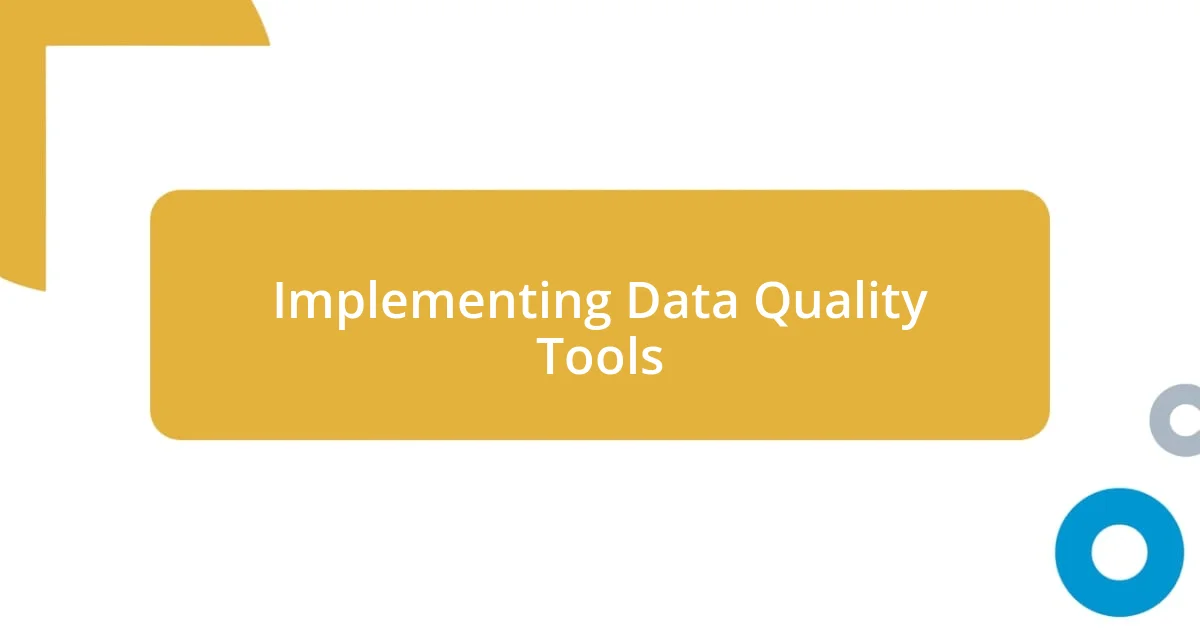
Implementing Data Quality Tools
Implementing data quality tools can significantly streamline the effectiveness of any data management effort. I remember the first time we integrated a data validation tool into our workflow; I couldn’t believe how much time we saved. It was like a breath of fresh air—suddenly, we had automated processes flagging errors before they spiraled out of control. I often ask myself, how did we ever operate without it?
One of the standout experiences for me was using a business intelligence tool that provided real-time dashboards. It allowed us to visualize our data quality metrics at a glance. Seeing those big red flags pop up made it impossible to ignore quality issues. I found myself getting excited each time we overcame a challenge; it felt like every small victory made a lasting impact on our overall data integrity. Have you ever had that moment when technology just clicks and transforms your approach?
Furthermore, the beauty of these tools lies in their adaptability. After implementing one tool, we realized it needed customization to fit our unique processes better. This wasn’t a setback; it was an opportunity. Collaborating with the software team, we fine-tuned the tool to cater to our specific needs, which genuinely felt like we were carving our path to data excellence. I encourage you to embrace that iterative approach—it’s where the magic happens.
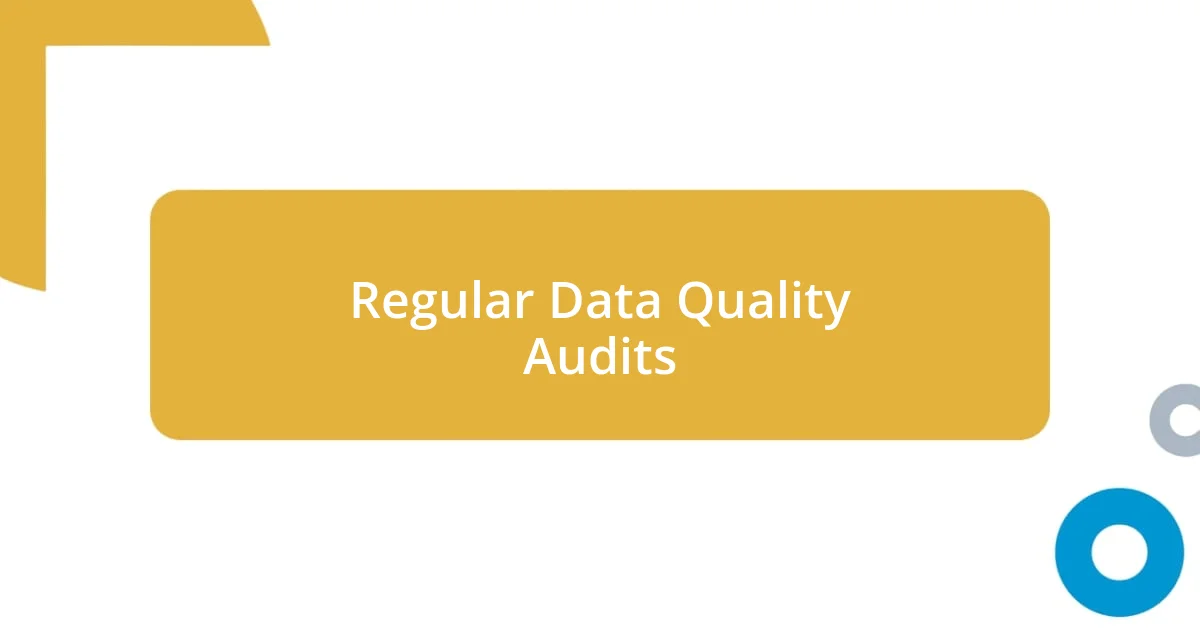
Regular Data Quality Audits
Regular data quality audits became a game-changer for my team, allowing us to catch issues before they grew into major problems. I still remember meeting with the analysts every quarter to dive into a meticulous review of our datasets. It was fascinating to observe how those sessions became our “data health check-ups,” where we discussed discrepancies and trends over time. I often wondered: how many quality issues would we have avoided if we hadn’t established this practice?
During one audit, we discovered a recurring issue with missing entries in our customer database. The data surfaced was frustrating, but it sparked a collective determination in our team. We brainstormed solutions, leading us to revise our data entry processes and implement mandatory fields. The transformation that followed was remarkable—seeing our data completeness improve felt like a victory, revitalizing our momentum. There’s something invigorating about turning a perceived failure into a stepping stone toward improvement, don’t you think?
I’ve come to believe that audits shouldn’t be feared; instead, they ought to be celebrated. They provide a structured opportunity to promote accountability and communication within the team. Each audit felt like an open forum where everyone brought ideas to the table, creating an environment rich with collaboration. Engaging in this process regularly reinforced the idea that we’re all stewards of data, striving for accuracy together. Isn’t it empowering to see how a simple practice can cultivate a culture of quality and teamwork?
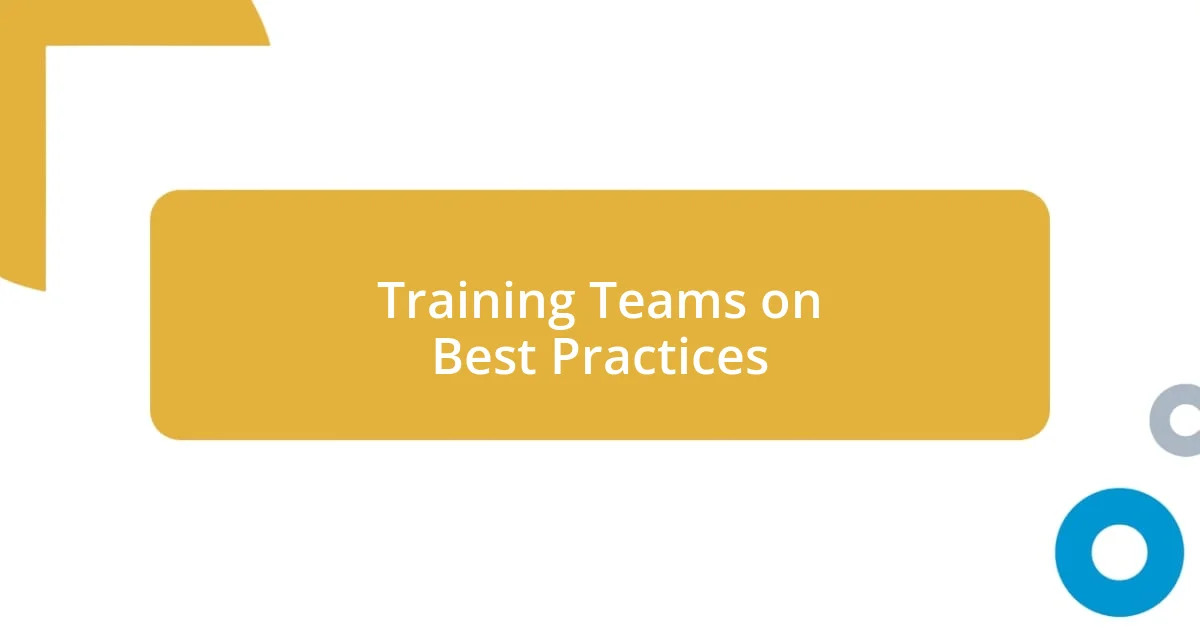
Training Teams on Best Practices
Training teams on best practices in data quality is critical to fostering a culture of accountability. I’ve experienced firsthand how a comprehensive training session transforms apprehensive team members into confident data stewards. One memorable workshop I conducted focused on real-life data-entry scenarios, allowing participants to troubleshoot and learn from actual challenges we faced. Watching team members light up as they realized their contributions could directly impact our data integrity was incredibly rewarding. Have you ever seen a team come alive when they understand their purpose?
It’s essential to underscore the importance of shared responsibility during these training sessions. I vividly recall when we introduced an interactive role-playing exercise that involved everyone in simulating data quality issues. The laughter and engagement were contagious as we tackled what could go wrong, and in that moment, barriers dissolved. Participants began to share their experiences and ideas freely, forming bonds that turned our group into a unit committed to quality. Isn’t it fascinating how a little creativity can ignite passion in even the driest of subjects?
One aspect I’ve found invaluable is incorporating ongoing training—data quality isn’t a one-off lesson but a continuous journey. I remember implementing monthly refresher sessions where team members would present their own “data wins.” Recognizing these victories, no matter how small, has been essential in building momentum and enthusiasm across the board. It’s crucial to ask ourselves: how do we keep the energy alive? By embedding best practices into our everyday conversations, we ensure data quality remains a top priority, creating an environment where everyone feels empowered to contribute to our success.
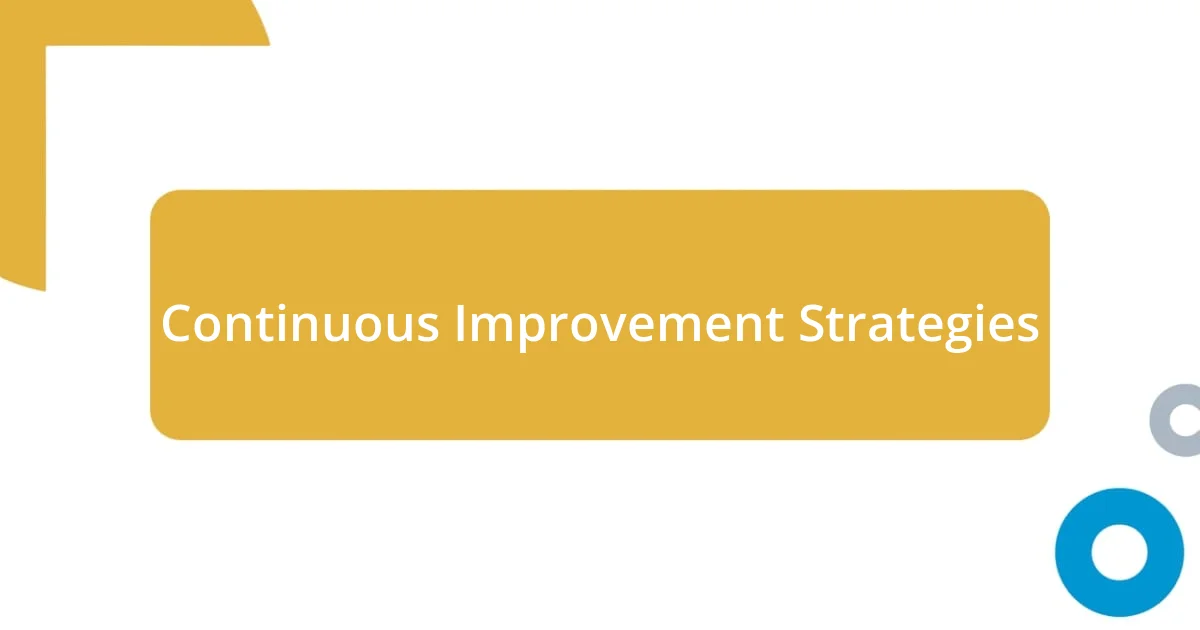
Continuous Improvement Strategies
One strategy I found invaluable for continuous improvement is fostering open communication among team members. During a particularly challenging project, our team embraced a shared chat platform where we could discuss data quality concerns in real-time. I was amazed at how quickly this simple change led to addressing issues before they spiraled out of control. Have you ever noticed that just talking things through can bring clarity to a chaotic situation? It’s become clear to me that creating an open forum for team discussions encourages collective problem-solving and cultivates trust.
Another effective approach involves establishing feedback loops. I remember when we implemented a system where team members could anonymously report data quality issues and suggest improvements. The first time someone shared constructive feedback, I hesitated—would my team take it the wrong way? To my surprise, it sparked a wave of insights, revealing hidden problems we had overlooked. It was eye-opening to witness how a culture of feedback could create opportunities for growth, ensuring everyone felt valued and included in our mission for data excellence.
Integrating technology to monitor our data quality also played a significant role in our continuous improvement journey. I still recall when we first invested in automated data quality tools. Initially, it felt overwhelming to transition from manual checks. However, seeing the immediate catch of anomalies made me realize how indispensable these tools are. They not only saved us countless hours but also allowed my team to focus on strategic improvements rather than getting bogged down in routine checks. Isn’t it amazing how leveraging technology can elevate our data practices to a whole new level? Each of these strategies, when embraced wholeheartedly, has etched a profound impact on our approach to data quality.














